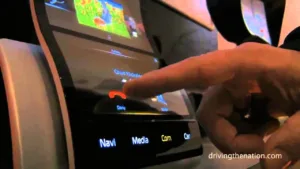Continental, the German based automotive supplier, has shown a curved AMOLED display for in-car use as the main information display. The news was published first by OLED-Info.com and hints at either an LG or Samsung panel as possible sources. (This seems to be a good guess for the moment.)
The following image shows what the design accomplishes.
There is also a video posted by Thomas Kruna showing the functionality of the prototype.
As can be seen in the video, the flexible AMOLED displays are used to create a concave/convex surface made up of two separate displays, so that each display is only bent in one direction. Continental also seems to like AMOLED displays because of the higher contrast ratio and deep blacks that the technology delivers.
The prototype combines the two separate displays into one functional surface adding capacitive touch to both panels. The panels are both bonded to glass panels according to Continental, requiring that the AMOLED panels are bonded to a curved glass panel after the front panel has been bent.
In another part of the video, Continental also showed an instrument cluster that incorporates AMOLED displays. In this case, the AMOLED display is used as a programmable information display, but also as a light source for the conventional instruments. Depending on the speed, the AMOLED changes color (a cool feature – NH).
Display Daily Comment
Considering all the uses of flexible displays I have seen so far, this prototype makes the most sense to me from a design standpoint. Modern cars do have to create a large flat surface in the center console to accommodate the information display. With most dashboards curved in one or more directions, this is certainly a design distraction and could be solved by using flexible AMOLED displays in the future.
With several German car makers already offering non-flexible AMOLED displays in their vehicles today, I guess that this application may be the first to adopt flexible displays going forward. – Norbert Hildebrand

